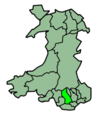Merthyr Line
| Merthyr Line | |
|---|---|
|
| |
| Overview | |
| Type | Heavy rail |
| System | National Rail |
| Locale |
Cardiff Rhondda Cynon Taff |
| Termini |
Cardiff 51°28′33″N 3°10′44″W / 51.4759°N 3.1790°W Merthyr Tydfil 51°44′41″N 3°22′38″W / 51.7446°N 3.3773°W Aberdare 51°42′52″N 3°26′31″W / 51.7145°N 3.4420°W |
| Operation | |
| Owner | Network Rail |
| Technical | |
| Number of tracks |
Double track Cardiff to Abercynon, single track with loops on Aberdare and Merthyr Tydfil branches |
| Track gauge | 4 ft 8 1⁄2 in (1,435 mm) standard gauge |
The Merthyr Line is a commuter railway line in South Wales from central Cardiff to Merthyr Tydfil and Aberdare. The line is part of the Cardiff urban rail network, known as the Valley Lines. It is historically the Taff Vale Railway, the first rail development in the Valleys in the 1840s and associated with the notorious Taff Vale Judgment in 1901 when the courts penalised trade unions for losses caused by strikes.
The line follows the Rhondda Line as far as Pontypridd, serving Cathays, Llandaf, Radyr, Taff's Well, Treforest and Pontypridd. It then divides at Abercynon with separate branches to Merthyr and Aberdare up diverging valleys.
The Merthyr branch serves Quakers Yard, Merthyr Vale, Troed-y-rhiw, Pentre-bach and Merthyr Tydfil. The Welsh Assembly Government confirmed in February 2007 that it is grant funding, in conjunction with European Union Objective 1 assistance, a scheme to upgrade the line north of Abercynon, including reinstatement of 2 miles of double track, to enable the introduction of a half-hourly train service, the revenue costs of which the Welsh Assembly Government will also meet. The enhanced service is said to commence sometime in 2008 (since postponed to May 2009 [1][2]).
The Aberdare branch serves Penrhiwceiber, Mountain Ash, Fernhill, Cwmbach and Aberdare. The line continues beyond Aberdare - for goods purposes only - to serve Tower Colliery, which was the last deep coal mine to remain open in South Wales. Mountain Ash station was redeveloped with a grant from the Welsh Assembly Government in the early part of the decade, the scheme including the provision of a new station and a passing loop to permit an upgrade of the passenger service to two trains per hour from late 2003. There are a few gaps in the half-hourly service to enable coal/stone trains to run to/from Tower Colliery/Hirwaun.
In 2005, following further grant from the Welsh Assembly, the stations at Abercynon, Penrhiwceiber, Fernhill, Cwmbach and Aberdare were extended to four-car length to accommodate longer peak trains in an initiative to relieve overcrowding, train leasing/running costs also funded by the Welsh Assembly Government.
The line is currently operated by Arriva Trains Wales (ATW) as part of the Valley Lines network. ATW replaced the previous franchise, Wales & Borders in December 2003.
Extension to Hirwaun

Since its termination at Aberdare following the Beeching Axe, there have been various proposals to extend the line northwards towards Hirwaun again. In recent years, these have been driven by the Welsh Assembly Government.
In 2006, a study by local transport alliance Sewta appeared to rule out any such extension for the foreseeable future.
In November 2009, WAG sponsored Network Rail in a feasibility study to reopening both the section to Hirwaun, and parts of the former Anglesey Central Railway between Llangefni on Anglesey, and Bangor. Network Rail has already begun work on gathering evidence for its study, beginning with cutting away vegetation on track sections to examine the condition of rails and track bedding. Its report is expected to be published in early 2010, before any business case to reopen the lines can be developed.[3]
It was announced in March 2011 that the Welsh Assembly Government’s 2011-12 capital programme would include the re-opening of the line to Hirwaun as part of the Cynon Valley Scheme.[4] There is currently no information on when the work will commence and when the line will re-open.
Electrification
On 16 July 2012 plans to electrify the line were announced by the Government as part of a £9.4bn package of investment of the railways in England and Wales.[5]
The announcement was made as an extension of the electrification of the South Wales Main Line from Cardiff to Swansea and the electrification of the south Wales Valley Lines at a total cost of £350 million. The investment will require new trains and should result in reduced journeys times and cheaper maintenance. It is thought to start between 2014 and 2019.[6]
See also
References
- ↑ Green Light for New Rail Links Welsh Assembly website; retrieved 2009-03-04
- ↑ New half-hourly train service due to start Wales Online; Retrieved 2009-05-14
- ↑ "Old tracks could see trains again". BBC News. 2009-03-05. Retrieved 2009-11-06.
- ↑ http://www.walesonline.co.uk/news/local-news/aberdare/2011/03/24/aberdare-to-hirwaun-rail-line-set-to-reopen-91466-28381233/
- ↑ "£9Bn Railway Investment Announced By Coalition". BBC News. 2012-07-16.
- ↑ "Rail electrification to Swansea and south Wales valleys welcomed". BBC News. 2012-07-16.
Further reading
| Wikimedia Commons has media related to Merthyr Line. |
- Allen, David (6–19 May 1998). "Taff Vale Update". RAIL. No. 330. EMAP Apex Publications. pp. 38–39. ISSN 0953-4563. OCLC 49953699.
Coordinates: 51°36′50″N 3°19′50″W / 51.6140°N 3.3306°W


